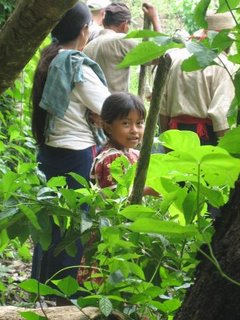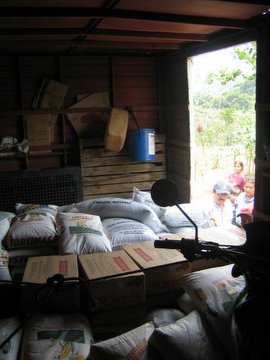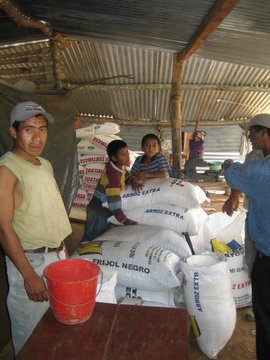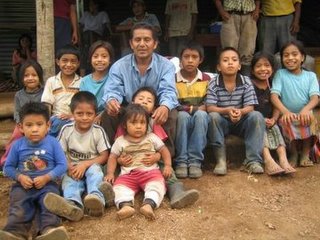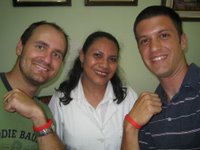Today in Tabacal I took the role of teacher. (Tabacal is on the side of a mountain and only has a few inches of good soil before becoming nasty clay and once the topsoil is washed away the land becomes virtually unusable. Our first priority is learning how to guard the soil that currently exists and then how to create more topsoil through composting). I had a meeting with 5 of the leaders of the community to talk about how to keep Tabacal producing crops in the future. Unfortunately I was teaching information that I myself had just learned so I admitted to the men that we would be learning together. We all had a good laugh and then I started.

Surprisingly enough they actually had a whiteboard and marker?! I was curious how I would teach effectively on only a legal sized pad of paper (cargo is limited when your means of travel is a motocross bike). The lesson of the day was Soil Conservation through Planting Techniques. Using a constructed level to know when you need to plant in contours on a hillside to filter water as it flowed downhill and when terraces are needed. So I drew and explained with all of them listening and noding as if to say I understand (if you look carefully in the first picture you can see my wonderful stick figures). Don Tomas was nodding too but his nods said more "I'm really tired" than "I am following what you are saying" luckily he got up to speed when we had hands on projects and practice.
After an explanation of what the level is and why we need it we started to build o
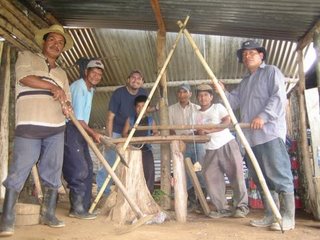
ne (it was the first one I would build also). Luckily it turned out great. It is composed of tying two bamboo poles about 2m long along the sides with a stick across the middle making a large capital A. Then a rock dangles from a string tied to the peak of the bamboo to show a line on the cross stick in the middle. We calibrated the level to find the exact position of the string for perfectly level and then by swiveling one leg uphill or downhill, another position exactly level can be found. By getting a string to measure the distance between the two legs and folding it a certain number of times and then lifting one of the legs that height and marking the cross stick again we delineated when no specific measures need to be followed, when contour planting is needed, and when terraces are needed. We also marked a specific small slope to let water escape when building terraces as well as how to build terraces. It was a lot to understand and soak in for the men.
We practiced marking a new level and using the level to determine the needs of different pieces of land. We also

practiced pivoting the level on a hillside to "walk" the level at the same elevation to show a line where they can plant and then where the next row goes as well as other erosion prevention techniques. All this to say that we had a fun time laughing at our attempts to learn a new thing.
I will be going back to Tabacal next week to review the system. We have about 2 months to get the training done because in two months the chili crop will be finished and it will be time to plant something new. Hopefully then we can implement these techniques. Unfortunately the rainy season has come early this year and they are antsy to plant. Within the past two weeks they have planted corn all over town. The reason this is unfortunate is that they all are planted in areas that need contour planting but are planted in normal rows. I had asked if there would be any more areas to plant but they said that all the areas had already been planted in the past two weeks and no more would be done. I think it may have been to new and difficult for them to follow these techniques so soon anyway but it is a shame to see the missed opportunity. Hopefully I can talk with the agro engineer once more to see if there are any measures we can implement in existing areas to save as much soil as we can.
Changing the subject, I nearly hit a puppy on my way TO Tabacal. He ran into the road and I locked both wheels as he turned and bumped into the side of my front tire. Luckily he ran off into the bushes terrified at the brush with death but unscathed. On my way FROM Tabacal I went to explore a beautiful rock outcropping nearby. On my way there I ran

over a 6' long green snake! I couldn't believe it so I turned around and went back. He had slithered off the road and into the grass where he was perfectly camouflaged but his tail was still sticking out about 8" into the gutter of the road. With my heart pounding out of my chest I finally worked up enough courage to grab him by the tail and fling him back out into the road. Needless to say he was less than thrilled about my jerking him through the air back into the road. I just wanted to see him better. After making it clear to me that he di

d not want to be disturbed, he slithered back into the grass on the side of the road. Due to either my stubbornness or insatiable curiosity, I grabbed him again and flicked him once more into the road but my adrenaline was pumping so I actually flicked him across the road and into the grass on the other side. This would not work so for the third time I grabbed him and, this time with more control and precision, I placed him directly in the middle of the road. Unfortunately a bus was passing by and, just as with my motorcycle. The poor snake positioned himself in the precise position of the back tires of the bus.
For a moment I felt terrible but then remembered it was a snake and now I could get a good look at it. I stretched it out to find that it was a little more than 6' long. Though it was barely alive it still wanted to bite me as seen in the picture (though I do not blame him one bit).
I continued on to the rocks and passed over a

bridge that had no base across it except pieces of boards and rubble to walk on. I carefully and quickly rode over it on my bike. It was very beautiful. Another one of those places in
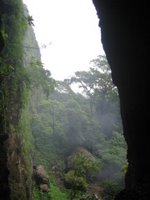
Guatemala that pictures do no justice and words just are not enough. God is good!
On a final note, while riding on the main road back home I was thinking, "I almost ran over a dog this morning and then a snake this afternoon..." before I finished my thought a big yellow bird flew across the road and came less than a meter from my head, "A dog then a snake and now a bird. What is going on with the animals today!" I would like to say that was the end of the adventures of the day but I ran out of gas on the way home... but this post is already too long. Lets just say the Guatemala is a great place to experience LIFE!
 Today Tom, Raul, Andy and I traveled to San Juan Bautista where we have been building three homes that were destroyed during Stan. It is HOT there but this particular day was overcast so instead of being super hot it was just hot and very humid. As you can see the space available to build was small. we had a fun time sharing both tools and space.
Today Tom, Raul, Andy and I traveled to San Juan Bautista where we have been building three homes that were destroyed during Stan. It is HOT there but this particular day was overcast so instead of being super hot it was just hot and very humid. As you can see the space available to build was small. we had a fun time sharing both tools and space.  Raul put together the high efficiency wood cooking stove and was showing the people how to use it. It was placed outside for the families to share. Initially we thought they wanted it outside for fear of smoke inside but really it was because they didn't want to add any heat to the homes. We definately understood that!
Raul put together the high efficiency wood cooking stove and was showing the people how to use it. It was placed outside for the families to share. Initially we thought they wanted it outside for fear of smoke inside but really it was because they didn't want to add any heat to the homes. We definately understood that! Near the end of the day the thunder started to crackle but we only had two walls left to construct. We decided to build one wall before the rain would come and then go home. Well, after that wall was done there still
Near the end of the day the thunder started to crackle but we only had two walls left to construct. We decided to build one wall before the rain would come and then go home. Well, after that wall was done there still  was no rain so we started the last wall. just after we started the wall it also started to rain. We worked a little faster and then the rain came down harder. This cycle kept spiraling until we were working furiously while being equally punished by the falling rain. By the time we went
was no rain so we started the last wall. just after we started the wall it also started to rain. We worked a little faster and then the rain came down harder. This cycle kept spiraling until we were working furiously while being equally punished by the falling rain. By the time we went  home we were thoroughly beat. Andy tipped his hand in the car showing exactly how tired he really was.
home we were thoroughly beat. Andy tipped his hand in the car showing exactly how tired he really was.










